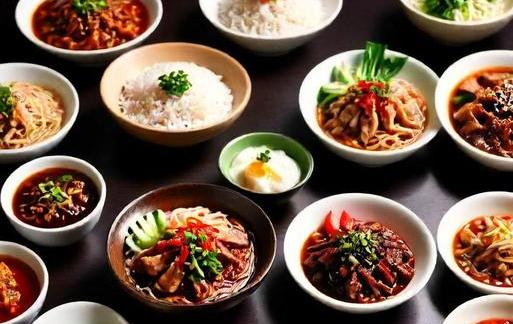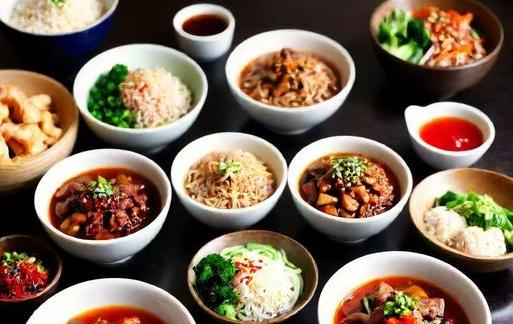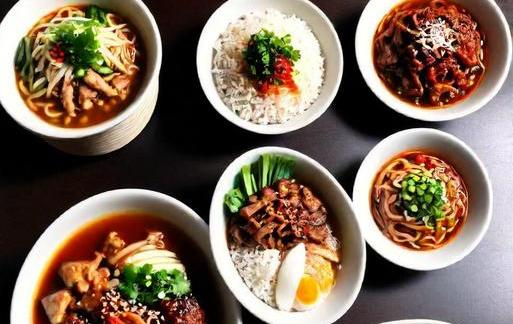- You are here:
- Home »
- Food
- » [REVEALED] Asian Foods That Start With O
[REVEALED] Asian Foods That Start With O
Note: This page contains affiliate links.
As an Amazon Associate, I earn from qualifying purchases when you click on the link, but you are not charged extra.
Asian cuisine is a rich tapestry of flavors, textures, and aromas that captivate the senses. Exploring the diverse culinary landscape of Asia unveils a myriad of dishes, each contributing to the region’s gastronomic heritage. In this culinary journey, we focus on Asian foods that start with the letter “O”. From savory delights to sweet indulgences, the selection encompasses a wide range of dishes that reflect the cultural diversity and culinary excellence found in Asia.
Contents
List Of Asian Foods That Start With O

1. Okonomiyaki (お好み焼き)
Description: Originating from Japan, Okonomiyaki is a savory pancake made with a batter of flour, grated yam, eggs, shredded cabbage, and various ingredients like pork, seafood, or cheese. The word "Okonomi" means "what you like," reflecting the versatility of this dish. It is often topped with okonomiyaki sauce, mayonnaise, seaweed flakes, and bonito flakes.
Ingredients:
- Flour
- Grated yam
- Eggs
- Shredded cabbage
- Pork or seafood
- Okonomiyaki sauce
- Mayonnaise
- Seaweed flakes
- Bonito flakes
How it’s Made:
- Combine flour, grated yam, eggs, and shredded cabbage to form a batter.
- Add your preferred protein, such as pork or seafood.
- Cook on a griddle until both sides are golden brown.
- Top with okonomiyaki sauce, mayonnaise, seaweed flakes, and bonito flakes.
2. Onigiri (おにぎり)
Description: Onigiri, also known as rice balls, is a popular Japanese snack or light meal. It consists of rice formed into triangular or cylindrical shapes and often wrapped with nori (seaweed). Onigiri can be filled with various ingredients like pickled plum (umeboshi), grilled salmon, or tuna. It is a convenient and portable dish commonly enjoyed for its simplicity and versatility.
Ingredients:
- Cooked rice
- Nori (seaweed)
- Filling options (umeboshi, grilled salmon, tuna, etc.)
How it’s Made:
- Take a handful of cooked rice and shape it into a triangle or cylinder.
- Place your chosen filling in the center.
- Wrap the onigiri with a strip of nori.
3. Oden (おでん)
Description: Oden is a Japanese one-pot dish featuring various ingredients like fish cakes, daikon radish, boiled eggs, and konjac simmered in a soy-based broth. This comforting and hearty dish is often enjoyed during the colder months and has regional variations in terms of ingredients and broth preparation.
Ingredients:
- Fish cakes
- Daikon radish
- Boiled eggs
- Konjac
- Soy-based broth
How it’s Made:
- Combine fish cakes, daikon radish, boiled eggs, and konjac in a pot.
- Pour a soy-based broth over the ingredients.
- Simmer until all components are tender and infused with flavor.
4. Osmanthus Jelly (桂花糕)
Description: Osmanthus jelly, known as "Guihua Gao" in Chinese, is a delicate and aromatic dessert made from sweet osmanthus flowers and a translucent jelly base. This dessert is renowned for its floral fragrance and subtle sweetness. Osmanthus jelly is often served chilled, making it a refreshing treat, especially during hot weather.
Ingredients:
- Osmanthus flowers
- Gelatin or agar-agar
- Sugar
- Water
How it’s Made:
- Steep osmanthus flowers in hot water to extract their fragrance.
- Dissolve gelatin or agar-agar in water and heat.
- Combine the osmanthus-infused water, sugar, and gelatin mixture.
- Allow the mixture to set into a jelly consistency.
5. Oxtail Soup
Description: Oxtail soup is a hearty and flavorsome dish found in various Asian cuisines, including Chinese, Indonesian, and Malaysian. The dish features oxtail slow-cooked with aromatic herbs and spices until the meat is tender and falls off the bone. The resulting broth is rich and robust, making it a comforting choice, especially in cooler weather.
Ingredients:
- Oxtail
- Aromatic herbs and spices
- Vegetables (carrots, potatoes, onions)
- Broth
How it’s Made:
- Brown the oxtail in a pot to enhance flavor.
- Add aromatic herbs, spices, and vegetables.
- Simmer the oxtail until it is tender and the flavors meld together.
6. Oyster Omelette (蚵仔煎)
Description: Oyster omelette, known as "O-a-chian" in Taiwanese cuisine, is a popular street food dish. It consists of a savory omelette made with a batter of sweet potato starch and rice flour, filled with fresh oysters, and topped with a tangy and savory sauce. The combination of textures and flavors makes this dish a delightful and indulgent treat.
Ingredients:
- Sweet potato starch
- Rice flour
- Oysters
- Eggs
- Sauce (soy sauce, vinegar, and garlic)
How it’s Made:
- Mix sweet potato starch and rice flour to create a batter.
- Add fresh oysters and pour the batter onto a hot griddle to form an omelette.
- Top with a flavorful sauce made from soy sauce, vinegar, and garlic.
7. Orange Chicken
Description: Orange chicken is a popular dish in Chinese-American cuisine, featuring crispy, battered, and fried chicken tossed in a sweet and tangy orange-flavored sauce. The vibrant combination of textures and flavors has made orange chicken a favorite in many households and Chinese restaurants around the world.
Ingredients:
- Chicken pieces
- Battering ingredients (flour, cornstarch, egg)
- Orange sauce (orange juice, soy sauce, sugar, ginger)
How it’s Made:
- Coat chicken pieces in a batter made from flour, cornstarch, and egg.
- Fry the chicken until crispy.
- Toss the fried chicken in a sauce made from orange juice, soy sauce, sugar, and ginger.
8. Octopus Takoyaki (たこ焼き)
Description: Takoyaki, a popular Japanese street food, features spherical savory snacks filled with minced or diced octopus, tempura scraps, pickled ginger, and green onions. The batter is cooked in a special takoyaki pan, creating a crispy exterior and a soft, flavorful interior. Takoyaki is typically topped with takoyaki sauce, mayonnaise, bonito flakes, and seaweed.
Ingredients:
- Takoyaki batter (flour, eggs, dashi)
- Octopus
- Tempura scraps
- Pickled ginger
- Green onions
- Takoyaki sauce
- Mayonnaise
- Bonito flakes
- Seaweed
How it’s Made:
- Pour takoyaki batter into a special pan, adding octopus, tempura scraps, pickled ginger, and green onions.
- Cook until the batter forms a crispy shell.
- Top with takoyaki sauce, mayonnaise, bonito flakes, and seaweed.
9. Orh Luak (蚝煎)
Description: Orh Luak, also known as oyster omelette, is a popular hawker dish in Singapore and Malaysia. It consists of a crispy omelette made with a batter of tapioca starch and rice flour, filled with fresh oysters, and seasoned with a spicy and tangy sauce. The contrast of the crispy texture and succulent oysters makes it a beloved dish in the region.
Ingredients:
- Tapioca starch
- Rice flour
- Oysters
- Eggs
- Sauce (chili sauce, garlic, vinegar)
How it’s Made:
- Mix tapioca starch and rice flour to create a batter.
- Add fresh oysters and pour the batter onto a hot griddle to form an omelette.
- Top with a sauce made from chili sauce, garlic, and vinegar.
10. Omurice (オムライス)
Description: Omurice is a Japanese dish that combines Western omelette and fried rice elements. It typically consists of fried rice seasoned with ketchup, wrapped in a thin omelette, and often topped with more ketchup or a demi-glace sauce. Omurice is a comforting and flavorful dish enjoyed by people of all ages in Japan.
Ingredients:
- Cooked rice
- Ketchup
- Eggs
- Vegetables (peas, carrots)
- Protein (chicken, ham)
How it’s Made:
- Stir-fry cooked rice with ketchup, vegetables, and protein.
- Whisk eggs and make a thin omelette.
- Place the fried rice in the center of the omelette and fold it over.
11. Otak-Otak
Description: Otak-otak is a traditional Indonesian and Malaysian dish made by wrapping a mixture of fish paste, coconut milk, and aromatic spices in banana leaves and grilling or steaming it. The result is a fragrant and flavorful fish cake with a unique texture. Otak-otak is often enjoyed as a snack or appetizer.
Ingredients:
- Fish paste
- Coconut milk
- Aromatic spices (turmeric, galangal, lemongrass)
- Banana leaves
How it’s Made:
- Mix fish paste, coconut milk, and aromatic spices to create a flavorful paste.
- Wrap the paste in banana leaves and secure with toothpicks.
- Grill or steam until the otak-otak is cooked through and fragrant.
The diverse array of Asian foods that start with the letter ‘O’ reflects the richness and complexity of Asian cuisine. From the savory delights of Okonomiyaki and Oyster Omelette to the sweet indulgences of Osmanthus Jelly, each dish tells a story of cultural traditions, regional variations, and a passion for culinary excellence. Whether you’re savoring the comforting warmth of Oden or delighting in the crispy textures of Octopus Takoyaki, the world of Asian cuisine invites you on a journey of flavors that captivate the palate and celebrate the artistry of food. As you explore these diverse dishes, you’ll find that the letter ‘O’ in Asian foods signifies not only a culinary category but a gateway to a world of taste sensations waiting to be discovered.
Significance

Asia, with its rich and diverse culinary heritage, is a treasure trove of flavors, textures, and aromas. From the bustling street markets of Southeast Asia to the refined kitchens of East Asia, the continent boasts a myriad of dishes that cater to various tastes and preferences. In this gastronomic exploration, we delve into the realm of Asian foods that start with the letter "O," uncovering the unique and delectable offerings that span different regions and cultures.
Understanding the significance of Asian foods that start with "O" requires a broader perspective on the culinary landscape of the continent. Each dish tells a story, reflecting historical, cultural, and geographical influences that have shaped the diverse cuisines we savor today. By exploring these foods, we gain insights into the traditions, ingredients, and cooking techniques that define the culinary identity of different Asian communities.
Category-Related

1. Oden (Japan)
Oden, a staple of Japanese winter cuisine, is a comforting one-pot dish featuring an assortment of ingredients simmered in a soy-based dashi broth. Common additions include fish cakes, daikon radish, konjac, and hard-boiled eggs. The slow simmering process allows the flavors to meld, creating a soul-warming dish that has been enjoyed for generations.
2. Okonomiyaki (Japan)
Hailing from the streets of Osaka, Okonomiyaki is a savory pancake that combines shredded cabbage, batter, and various ingredients like meat, seafood, or cheese. Cooked on a griddle, it is then slathered with a generous amount of okonomiyaki sauce, mayonnaise, and sprinkled with bonito flakes and seaweed powder. The name translates to "grilled as you like it," allowing for endless variations.
3. Otak-Otak (Malaysia, Indonesia, Singapore)
A popular street food in Southeast Asia, Otak-Otak is a flavorful fish cake made from a mixture of ground fish, coconut milk, and aromatic spices. The mixture is wrapped in banana leaves and grilled, imparting a smoky aroma to the dish. Otak-Otak showcases the ingenious use of local ingredients, combining them to create a harmonious blend of taste and texture.
4. Oyster Omelette (Taiwan, Singapore, Malaysia)
Found in night markets across Taiwan and Southeast Asia, Oyster Omelette is a tantalizing street food dish that brings together fresh oysters, starch, and eggs. The result is a crispy and gooey concoction, often accompanied by a tangy and savory sauce. This dish exemplifies the region’s flair for transforming simple ingredients into gastronomic delights.
Common Themes
The Asian foods starting with "O" share common themes that highlight the culinary principles prevalent across the continent.
1. Umami Sensation
Whether it’s the savory broth of Oden, the rich flavors of Okonomiyaki, or the aromatic blend of spices in Otak-Otak, umami takes center stage. Asian cuisines often emphasize the balance of flavors, and the dishes starting with "O" are no exception. The umami sensation creates a depth of taste that elevates these dishes to culinary excellence.
2. Versatility In Ingredients
A notable theme in these dishes is the versatility of ingredients. From the various components in Oden to the diverse fillings in Okonomiyaki, Asian chefs exhibit a knack for using a range of ingredients in creative ways. This versatility not only enhances the flavors but also reflects the resourcefulness ingrained in Asian culinary traditions.
3. Street Food Culture
The prominence of street food in the list of Asian foods starting with "O" underscores the significance of street food culture in the region. Oden, Okonomiyaki, Otak-Otak, and Oyster Omelette are all street food delights that showcase the vibrancy and diversity of Asian street food scenes. These dishes are not only delicious but also offer a glimpse into the dynamic and fast-paced culinary experiences found in bustling markets.
Interesting Facts
Unearthing the fascinating facts about these Asian foods adds another layer to our understanding of their cultural and culinary importance.
1. Oden’s Seasonal Significance
In Japan, Oden is not just a dish; it is a culinary tradition deeply tied to the seasons. It is predominantly consumed during the colder months, and each region may have its variations of the dish. The assortment of ingredients often reflects local preferences and seasonal availability, making Oden a dynamic and ever-evolving culinary experience.
2. Okonomiyaki’s Evolution
While Okonomiyaki has its roots in Osaka, its popularity has transcended regional boundaries. Different areas in Japan have their own styles of Okonomiyaki, with variations in ingredients and preparation methods. The adaptability of the dish has even led to the emergence of Okonomiyaki-themed restaurants, where diners can customize their pancakes to suit their tastes.
3. Otak-Otak’s Heritage
The name "Otak-Otak" itself has an interesting origin. Derived from the Indonesian word "otak," meaning brain, it was initially used to describe the texture of the dish – soft and somewhat reminiscent of brain tissue. Over time, the term evolved to represent the unique grilled fish cake that has become a beloved delicacy in Malaysia, Indonesia, and Singapore.
4. Oyster Omelette’s Culinary Crossroads
The Oyster Omelette has a curious history, reflecting the culinary crossroads of Taiwan, Singapore, and Malaysia. While it originated in Taiwan, variations of the dish gained immense popularity in Southeast Asia, each region adding its unique twist. The dish exemplifies the way culinary traditions travel, adapt, and evolve across borders.
Conclusion
In the vast tapestry of Asian cuisine, the foods that start with "O" offer a delightful journey through flavors, traditions, and cultural nuances. From the comforting embrace of Oden to the customizable allure of Okonomiyaki, the bold flavors of Otak-Otak, and the savory perfection of Oyster Omelette, these dishes exemplify the culinary artistry that has made Asian cuisine a global sensation. As we savor each bite, we not only indulge in the sensory pleasures but also embark on a culinary expedition that transcends borders and celebrates the rich tapestry of Asian gastronomy.


